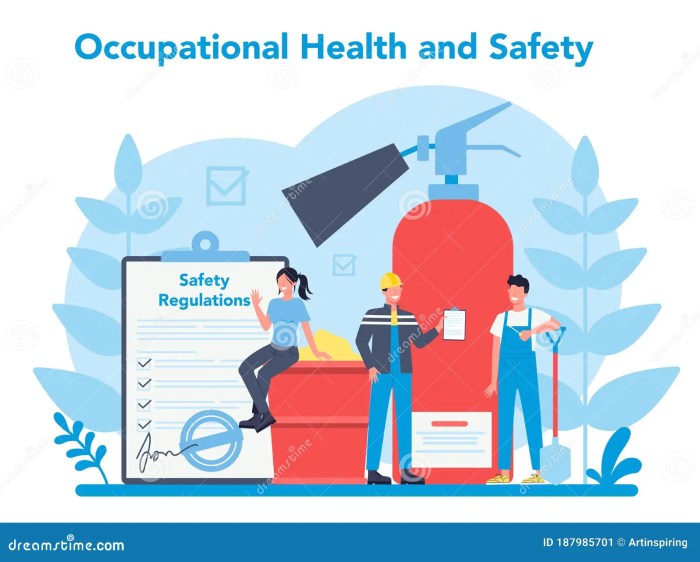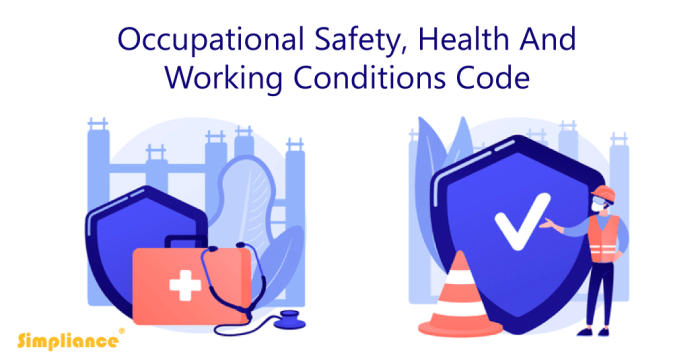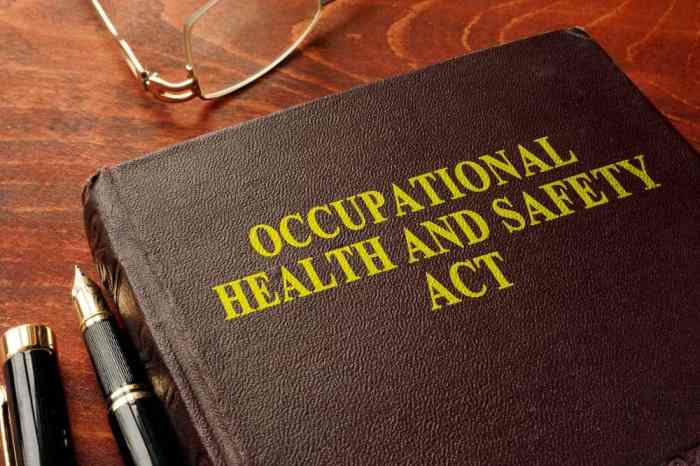Under The Occupational Health And Safety Act Employees Must: Rights, Responsibilities, And Compliance. This comprehensive guide delves into the crucial aspects of workplace safety, empowering employees with the knowledge they need to navigate their rights and obligations under OSHA regulations.
From understanding the general duty clause to implementing effective hazard control measures, this article provides a roadmap for creating and maintaining a safe and healthy work environment.
The content of the second paragraph that provides descriptive and clear information about the topic
Employees’ Rights and Responsibilities under OSHA
The Occupational Safety and Health Act (OSHA) grants employees the right to a safe and healthy workplace. This includes the right to:
- Be informed about workplace hazards and how to protect themselves from them.
- Request inspections of their workplace if they believe there is a hazard.
- File a complaint if they believe their employer is violating OSHA regulations.
- Participate in workplace safety and health programs.
Employees also have the responsibility to comply with safety regulations and to follow their employer’s safety procedures.
Responsibilities of Employees to Comply with Safety Regulations
Employees have a responsibility to comply with safety regulations and to follow their employer’s safety procedures. This includes:
- Wearing appropriate personal protective equipment (PPE).
- Using equipment and machinery safely.
- Reporting any hazards or unsafe conditions to their supervisor.
- Participating in safety training programs.
Employer Obligations under OSHA

Under OSHA, employers have specific obligations to protect their employees from workplace hazards. These obligations include providing a safe and healthful workplace, and complying with OSHA standards.
The general duty clause of the OSH Act requires employers to provide a workplace free from recognized hazards that are causing or are likely to cause death or serious physical harm to employees.
Specific OSHA Standards
OSHA has developed specific standards that address a wide range of workplace hazards, including:
- Hazard communication
- Machine guarding
- Respiratory protection
- Electrical safety
- Fall protection
These standards specify the requirements that employers must meet to protect their employees from these hazards.
Hazard Identification and Risk Assessment
Workplace hazards can lurk in various forms, posing risks to employees’ health and well-being. To ensure a safe work environment, it is crucial to identify and assess these hazards proactively. This process, known as hazard identification and risk assessment, plays a vital role in preventing accidents, illnesses, and ensuring compliance with OSHA regulations.
Under The Occupational Health And Safety Act Employees Must always have the right to know about and refuse any work that could harm them or others. They should also be trained on how to do their jobs safely. In the gripping My Son French Movie , a father’s desperate search for his missing son highlights the importance of workplace safety and the devastating consequences that can arise when it’s compromised.
This film serves as a powerful reminder of the crucial role employers play in ensuring the well-being of their employees.
Effective hazard identification involves actively searching for potential hazards in the workplace. This can be done through various methods, such as workplace inspections, job safety analyses, and employee feedback. By observing the work environment, tasks performed, and equipment used, potential hazards can be identified and documented.
Risk Assessment
Once hazards are identified, the next step is to assess the associated risks. Risk assessment involves evaluating the likelihood and severity of potential accidents or illnesses that could result from the identified hazards. This assessment helps prioritize hazards based on their potential impact and determine appropriate control measures.
Risk assessment can be conducted using qualitative or quantitative methods. Qualitative methods involve assigning risk levels based on expert judgment and experience, while quantitative methods use data and calculations to estimate the probability and consequences of hazards. By understanding the risks associated with each hazard, employers can develop effective strategies to mitigate or eliminate them.
Hazard Control and Prevention

Controlling and preventing workplace hazards is crucial for protecting employees’ health and safety. Various approaches can be implemented to eliminate or minimize risks associated with workplace hazards.
One approach is engineering controls, which involve modifying the workplace or equipment to reduce hazards. Examples include installing machine guards, improving ventilation systems, or automating tasks to reduce exposure to hazardous substances.
Administrative Controls
Administrative controls focus on changing work practices and procedures to minimize risks. This includes implementing safety policies, providing training to employees, and establishing work schedules that reduce exposure to hazards.
Personal Protective Equipment (PPE)
PPE is used when other control measures are not feasible or sufficient. Examples include respirators, gloves, safety glasses, and earplugs. PPE should be selected based on the specific hazards present and should be used properly to ensure effectiveness.
Safety Training and Education
Safety training and education are vital components of a comprehensive occupational health and safety program. They equip employees with the knowledge, skills, and attitudes necessary to identify and mitigate workplace hazards, reducing the risk of accidents, injuries, and illnesses.
Under The Occupational Health And Safety Act Employees Must adhere to certain guidelines. These guidelines are put in place for the safety of all workers and must be followed closely. Understanding the Collector Ticket Meaning is a crucial aspect of maintaining workplace safety.
By comprehending the regulations outlined in the Occupational Health And Safety Act, employees can ensure a safe and healthy work environment.
There are various types of safety training programs tailored to specific industries, job roles, and hazard profiles. These programs may include:
General Safety Training
- Introduction to occupational health and safety
- Hazard recognition and risk assessment
- Emergency preparedness and response
- Personal protective equipment (PPE) use
Job-Specific Safety Training
- Safe work practices for specific tasks or equipment
- Industry-specific regulations and standards
- Hazard control measures and best practices
Specialized Safety Training
- Confined space entry
- Working at heights
- Hazardous materials handling
Accident Investigation and Reporting
Accident investigation and reporting are crucial aspects of workplace safety. They help identify the causes of accidents, prevent recurrences, and ensure compliance with OSHA regulations.
Workplace accidents can have devastating consequences, including injuries, fatalities, and property damage. Investigating these incidents thoroughly is essential to determine the root causes and implement effective preventive measures.
Steps in Accident Investigation, Under The Occupational Health And Safety Act Employees Must
- Secure the accident scene:Protect the area to prevent further injuries or damage.
- Gather information:Collect witness statements, inspect the equipment, and document the scene.
- Analyze the evidence:Determine the sequence of events, identify hazards, and establish the root causes.
- Develop corrective actions:Recommend measures to prevent similar accidents from occurring in the future.
- Report the accident:Notify OSHA and other relevant authorities as required by law.
OSHA Reporting Requirements
Employers are required to report certain workplace accidents and injuries to OSHA within specific timeframes:
- Fatalities:Report within 8 hours.
- Hospitalizations:Report within 24 hours.
- Amputations:Report within 24 hours.
- Loss of an eye:Report within 24 hours.
Failure to report accidents promptly can result in fines and other penalties.
Compliance and Enforcement

OSHA is responsible for enforcing safety regulations in workplaces across the country. The agency has a team of compliance officers who conduct inspections to ensure that employers are complying with OSHA standards. If an employer is found to be in violation of OSHA standards, the agency can issue citations and fines.The
consequences of non-compliance with OSHA standards can be severe. Employers who are found to be in violation of OSHA standards can face fines of up to $13,653 per violation. In addition, employers who are found to be in violation of OSHA standards can be held criminally liable.
Consequences of Non-Compliance
The consequences of non-compliance with OSHA standards can be severe. Employers who are found to be in violation of OSHA standards can face fines of up to $13,653 per violation. In addition, employers who are found to be in violation of OSHA standards can be held criminally liable.
Closure: Under The Occupational Health And Safety Act Employees Must
In conclusion, adhering to the Occupational Health And Safety Act is not merely a legal obligation but an ethical imperative. By embracing their rights and fulfilling their responsibilities, employees play a vital role in fostering a culture of safety in the workplace.
Employers, in turn, must prioritize the well-being of their workforce by providing a safe and hazard-free environment. Together, we can create workplaces where every employee feels valued, protected, and empowered to contribute to a thriving and sustainable organization.
Query Resolution
What are the key rights of employees under OSHA?
Employees have the right to a safe and healthy workplace, to be informed about workplace hazards, to receive training on how to protect themselves from hazards, and to participate in workplace safety and health programs.
What are the key responsibilities of employers under OSHA?
Employers are responsible for providing a safe and healthy workplace, for identifying and assessing workplace hazards, for implementing hazard control measures, and for providing training to employees on how to protect themselves from hazards.
What are the consequences of non-compliance with OSHA standards?
Employers who fail to comply with OSHA standards may be subject to fines, citations, and other penalties.